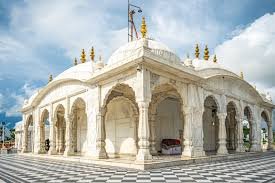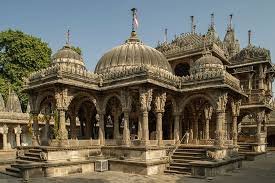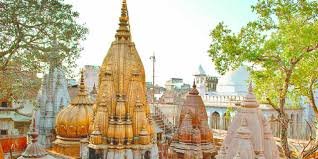Nestled in the serene town of Pawapuri, Bihar, the Jalmandir stands as a breathtaking symbol of peace, spirituality, and devotion. This sacred temple holds immense significance in Jainism, as it marks the site where Lord Mahavira, the 24th Tirthankara, attained Nirvana (liberation). Surrounded by a tranquil lotus-filled lake, this stunning white marble temple exudes an aura of divinity and serenity, drawing devotees and tourists alike.
If you are looking for a spiritually uplifting journey or simply want to witness a magnificent architectural marvel, Jalmandir in Pawapuri is a must-visit destination. Let’s dive deeper into its history, legends, architecture, and religious significance.
The Sacred History of Jalmandir
Jalmandir is not just a beautiful temple; it is a site of great historical and religious importance. It is believed that in 527 BCE, Lord Mahavira, the founder of Jainism, attained Moksha (liberation from the cycle of birth and death) at this very place.
How Jalmandir Became a Sacred Site
- After Lord Mahavira’s Nirvana, his followers wanted to cremate his mortal remains at Pawapuri.
- However, thousands of devotees came from different parts of India to take a handful of sacred ashes from his funeral pyre.
- As people continued to collect ashes and soil, the land sank, forming a large pond.
- To honor the great saint, King Nandivardhan, the elder brother of Mahavira, decided to construct a beautiful temple in the center of this lake.
- Over time, the temple became a pilgrimage site for Jains, symbolizing peace, purity, and liberation.
Even today, the temple stands as a reminder of Lord Mahavira’s teachings, inspiring millions to follow the path of non-violence, truth, and self-discipline.
The Architectural Marvel of Jalmandir
Apart from its spiritual significance, the Jalmandir is an architectural masterpiece that leaves visitors in awe.
1. The White Marble Structure
- The entire temple is constructed from white marble, giving it a majestic and divine appearance.
- The temple’s intricate carvings and detailed craftsmanship reflect the rich architectural heritage of India.
2. The Lotus-Laden Lake
- The temple sits right in the middle of a large lake, surrounded by thousands of blooming lotus flowers.
- The lake not only enhances the beauty of the temple but also adds to the sense of tranquility and purity.
3. The Stone Bridge Connection
- A narrow stone bridge, approximately 600 feet long, connects the temple to the shore.
- Walking across this beautiful pathway feels like a spiritual journey, symbolizing the transition from the material world to the divine realm.
4. The Sacred Footprints
- Inside the temple, you will find the footprints of Lord Mahavira, which are worshipped by devotees as a mark of his spiritual presence.
The breathtaking architecture, peaceful surroundings, and deep-rooted history make Jalmandir one of the most serene places of worship in India.
Religious Significance of Jalmandir
Jalmandir is not just a historic site; it is a major pilgrimage center for Jains. Every year, thousands of devotees visit this temple to seek spiritual enlightenment and pay homage to Lord Mahavira.
1. A Place of Moksha
- Since Lord Mahavira attained Moksha here, Jalmandir is considered one of the holiest sites in Jainism.
- Visiting this temple is believed to help devotees attain inner peace and liberation from worldly attachments.
2. Daily Rituals and Worship
- The temple follows strict Jain traditions and rituals.
- Devotees offer prayers, flowers, and sacred chants to honor Lord Mahavira.
- Special Jain pujas (prayer rituals) are performed daily, creating an atmosphere of divine serenity.
3. Grand Celebrations During Mahavir Jayanti
- Mahavir Jayanti, the birth anniversary of Lord Mahavira, is celebrated with great devotion at Jalmandir.
- Thousands of devotees gather to offer prayers, participate in religious discourses, and perform charitable activities.
4. Spiritual Teachings and Meditation
- The temple is a place of learning and meditation, where devotees contemplate Mahavira’s teachings on non-violence, truth, and self-discipline.
- Many monks and spiritual seekers come here to practice deep meditation and attain inner peace.
The calm and spiritual energy of the temple makes it a perfect place for self-reflection and spiritual growth.
Why You Should Visit Jalmandir
Jalmandir is more than just a religious site; it is a destination that offers peace, history, and beauty. Here’s why you should visit this sacred place:
1. Experience Spiritual Bliss
- If you are looking for a place to find peace and connect with your inner self, Jalmandir provides the perfect spiritual retreat.
2. Witness an Architectural Gem
- The stunning white marble temple, surrounded by a lotus-filled lake, is a visual treat for history and architecture lovers.
3. Learn About Jainism
- The temple serves as a great place to understand the teachings of Lord Mahavira, making it an ideal destination for spiritual seekers and historians.
4. Enjoy a Serene and Scenic Environment
- The tranquil setting, cool breeze, and sound of water create an atmosphere of calmness and positivity.
How to Reach Jalmandir, Pawapuri
- The nearest airport is Patna Airport, located about 90 km away.
- From there, you can hire a taxi or take a bus to Pawapuri.
- The nearest railway station is Pawapuri Road Railway Station, around 8 km away.
- Other major railway stations include Nalanda (22 km) and Rajgir (38 km).
- Jalmandir is well-connected by road to cities like Patna, Rajgir, Gaya, and Nalanda.
- You can hire a private taxi or take a state transport bus to reach the temple.
Best Time to Visit Jalmandir
- The ideal time to visit is from October to March, when the weather is cool and pleasant.
- Visiting during Mahavir Jayanti (March-April) offers a chance to witness grand celebrations.
Conclusion: A Spiritual Journey to Jalmandir
The Jalmandir in Pawapuri is not just a place of worship; it is a symbol of peace, devotion, and enlightenment. The temple’s spiritual ambiance, breathtaking architecture, and historical significance make it one of the most revered Jain pilgrimage sites in India.
Whether you visit for religious purposes, historical exploration, or simply to experience tranquility, Jalmandir will leave you feeling refreshed, inspired, and spiritually uplifted.
If you seek peace, wisdom, and divine blessings, Jalmandir is the perfect destination for you.





